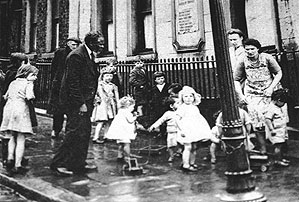
| HOME |
| NERVE |
| REVIEWS |
| ARCHIVE |
| EVENTS |
| LINKS |
| ABOUT US |
| CONTRIBUTORS |
| BACK ISSUES |
| CONTACT US |
Back to index of Nerve 9 - Autumn 2006
 A
Liverpool councillor recently suggested that in the run-up to 2007 –
the 200th anniversary of the passing of William Wilberforce’s Slavery
Trade Act – certain streets should be renamed.
A
Liverpool councillor recently suggested that in the run-up to 2007 –
the 200th anniversary of the passing of William Wilberforce’s Slavery
Trade Act – certain streets should be renamed.
Wilberforce? No Way!
By Tayo Aluko
I confess I didn’t realise that Liverpool’s Penny Lane was
named after an 18th century slave trader.
The proposal was withdrawn before it reached the council chamber, but
the idea still remains for a significant new building or street to be
named Wilberforce House, or Wilberforce Way. I beg to differ.
Wilberforce is credited by many as being responsible for the abolition
of the slave trade. It is largely forgotten that several years before
the abolition act, this devoted Christian had considered blacks “…not
yet fit…to bear emancipation”.
His later enlightenment was due partly to him meeting one Thomas Clarkson,
who was instrumental in setting up the Committee for Effecting the Abolition
of the Slave Trade in 1787. Before both these men, one Granville Sharp
acted as lawyer on behalf of some runaway slaves in London, and succeeded
in obtaining a ruling in 1771 preventing ex-slaves from being returned
to their former masters in the colonies.
Liverpool has already honoured one of her own abolitionists, William Roscoe,
who was physically assaulted on his return to Liverpool after making abolition
the subject of his maiden speech to Parliament in 1806. Yet to be acknowledged
to the same degree is Edward Rushton, who was working class, blind and
less restrained in his criticism of slave traders.
It would therefore appear that Wilberforce’s name belongs in a list
of many benevolent white men helping poor blacks. But wait a minute: what
about black names? Here are a few. Olaudah Equiano - a former slave who
bought his freedom, travelled the length and breadth of Britain educating
the public about slavery, and wrote a best-selling autobiography that
is still in print today.
There were others in the UK like Ottobah Cugoano, Robert Wedderburn and
Robert Mandeville. In the colonies and elsewhere, people revere names
like Sam Sharpe, Bussa and Toussaint L’Ouverture, whose successful
revolt on 23rd August 1791 is now commemorated internationally as Slavery
Remembrance Day.
From America came Sojourner Truth, Frederick Douglass, John Brown and
Harriet Tubman.
People are perhaps more familiar with more recent names like C.L.R. James,
Martin Luther King, Malcolm X, Angela Davis and Paul Robeson. From Africa
we have Kwame Nkrumah, Nana Yaa Asantewa, Patrice Lumumba, and of course
Nelson Mandela. There are many, many more.
Which of this host of great names would I suggest for the first significant
new building or street in Liverpool? None, in fact.
A young man arrived in Liverpool from Nigeria around 1915, expecting to
find the streets paved with gold. The Dingle area of Toxteth he ended
up in was instead depressed, poor, racist, and to his mind, ungodly. In
1931, he founded the African Churches Mission, in which he not only led
services but also housed, fed and clothed the poor of the community, foreign
seamen and others denied accommodation elsewhere.
Despite huge local popularity (he was known as the African Saint) he was
granted no meaningful state or voluntary support (not even from the Anti-Slavery
Society). Still, he and his mission soldiered on for over thirty years,
until the dilapidated building was finally demolished by the council in
1964.
A local housing association has just finished building a block of flats
on the site of the old mission. I understand that they are going to ask
the incoming tenants to name their new home. Whilst this is laudably democratic,
it misses a great opportunity. The African Saint’s name mustn’t
be buried along with the rubble of his mission. Indeed, perhaps one day,
somebody will be inspired by the history behind the building at the corner
of Hill Street and Hyslop Street, and write a song about Pastor Daniels
Ekarte.
Tayo Aluko runs Aluko Brooks Architects and Bisayo Properties (UK) Ltd
in Liverpool.
This article first appeared in The North West Enquirer on 27 July 2005.
Further reading: Pastor Daniels Ekarte and the African Churches Mission,
Liverpool, 1931-64, by Marika Sherwood (who also supplied the picture).
Black Liverpool, The Early History of Britain’s Oldest Black Community
1730-1918, by Ray Costello.
Both these books are available at News
From Nowhere.
Sorry Comments Closed
Comment left by Michael Corfe on 17th January, 2007 at 20:00
My God - how we whites need educating! Here I am in my sixties and a resident on Merseyside for nearly all of that time and I have never heard of Pastor Daniels Ekarte. Some thought needs to be given to getting a wider audience for such knowledge. JMC
Comment left by mbali on 4th May, 2008 at 14:48
thank you for helping us to reremember and honor those who came before us
Comment left by jim reeves on 13th May, 2009 at 13:33
I,m proud to say i new mr daniels